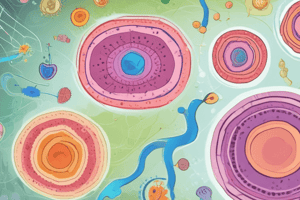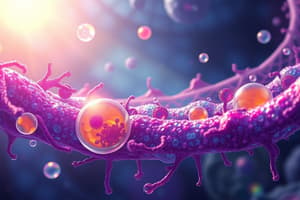Podcast
Questions and Answers
What is the main function of the cell membrane?
What is the main function of the cell membrane?
- To generate energy for the cell
- To store genetic information
- To regulate the movement of molecules in and out of the cell (correct)
- To synthesize proteins
Which organelle is responsible for generating energy for the cell through cellular respiration?
Which organelle is responsible for generating energy for the cell through cellular respiration?
- Ribosomes
- Lysosomes
- Mitochondria (correct)
- Endoplasmic Reticulum
What is the primary function of chloroplasts in plant cells?
What is the primary function of chloroplasts in plant cells?
- Waste recycling
- Protein synthesis
- Cellular respiration
- Photosynthesis (correct)
Which organelle is involved in protein synthesis, folding, and transport?
Which organelle is involved in protein synthesis, folding, and transport?
What is the main function of lysosomes in cells?
What is the main function of lysosomes in cells?
What is the primary function of the Golgi apparatus?
What is the primary function of the Golgi apparatus?
What is the main function of the cytoskeleton in cells?
What is the main function of the cytoskeleton in cells?
What is the main component of the cell wall in plant cells?
What is the main component of the cell wall in plant cells?
Flashcards are hidden until you start studying
Study Notes
Cell Membrane
- Also known as the plasma membrane, it is a thin, semi-permeable layer that surrounds the cell
- Composed of a phospholipid bilayer with embedded proteins
- Functions:
- Regulates the movement of molecules in and out of the cell
- Provides mechanical support and maintains cell shape
- Acts as a barrier against external substances
Organelles
Animal Cells
- Mitochondria: generates energy for the cell through cellular respiration
- Endoplasmic Reticulum (ER): involved in protein synthesis, folding, and transport
- Ribosomes: site of protein synthesis
- Lysosomes: contains digestive enzymes that break down and recycle cellular waste
- Golgi Apparatus: modifies and packages proteins and lipids for transport
- Cytoskeleton: provides structural support and shape to the cell
Plant Cells
- Chloroplasts: responsible for photosynthesis, converting light energy into chemical energy
- Vacuoles: stores water, nutrients, and waste products; helps maintain cell turgor pressure
- Plastids: involved in pigment synthesis and storage
- Cell Wall: provides structural support and protection; composed of cellulose, hemicellulose, and pectin
Note: Plant cells have additional organelles not found in animal cells, such as chloroplasts and a cell wall.
Studying That Suits You
Use AI to generate personalized quizzes and flashcards to suit your learning preferences.




